The complex welding universe includes many problems, undercut being one of them.
This welding defect is common and occurs with frequently used materials and joints.
So, those just starting must have basic knowledge of this unwelcome flaw to help them tackle it.
This article covers welding undercut and its causes, solutions, and removal techniques.
What is Undercut?
Undercut in welding refers to a defect where a groove or depression runs along the toe of the weld. This happens when the base material has melted and has not been properly filled by the filler metal. Undercut weakens the structural integrity of the welded joint, making it more susceptible to cracks and failures.

© weldguru.com – Image usage rights
For example, suppose you’re welding two 6mm plates (0.236″ or 15/64″) with a butt joint. Ideally, you would want the weldment and surrounding area to be at least 6mm thick.
But if there’s an undercut, the thickness will be less than 6mm at the weld toe or root. This thickness compromises the joint’s structural integrity at these points.
In most cases, these low-thickness areas are the first to crack under loading.
Undercut also decreases a joint’s strength by trapping water and dirt. The captured water accelerates corrosion in this already weakened area, which causes premature mechanical failure of the part.
What is the Acceptable Amount of Undercut?
The acceptable amount of undercut varies, but any undercut deeper than 1/16” renders the part rejected according to AWS D1.1 Code. For welders not adhering to strict guidelines, undercuts below 0.5 mm (.02 in.) are usually considered safe.
To measure undercut, the upper limit is 1/16″, and the lower limit is 1/32″. Within this range, the weld inspector must assess the total length of undercuts; if they exceed 2” in a 12” section, the part won’t pass.
Now, how do you decide if an undercut is acceptable?
There are two approaches.
The informal way is to rely on visual checks, considering factors like joint type, material strength, and thickness. A trade trick is to see if your fingernail catches on the undercut—if it does, it’s too deep.

© weldguru.com – Image usage rights
The more formal method involves following the American Welding Society’s (AWS) guidelines, which specify that any undercut below 1/32” is harmless so long as it doesn’t exceed certain lengths.
Proper measurement tools like a V-WAC single weld gage or a bridge cam gage are the most reliable methods for assessing undercut depth.
3 Main Causes of Undercut
The primary causes of undercut in welding are wrong welding parameters, incorrect electrode and shielding gas selection, and poor welding techniques.
Each of these factors contributes to the formation of undercut, leading to weakened joints and defects in your welds.
Let’s take a closer look at the causes.
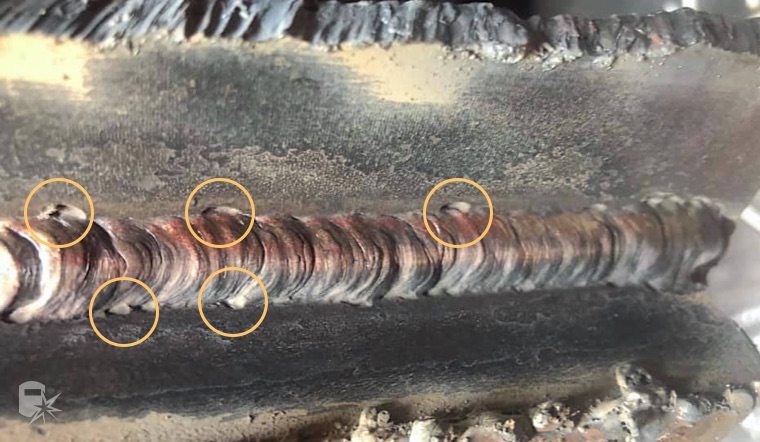
© weldguru.com – Image usage rights
1. Wrong Welding Parameters
In most cases, the wrong welding parameters are the main culprit behind undercuts.
High Current
Current determines how much energy goes into the weld. The base metal melts more than required if it’s too high, forming a deeper weld pool.
The extra amount of liquefied metal flows away from the boundaries into the pool. This occurrence leaves a crater at the edges.
High Travel Speed
High electrode travel speed and undercutting have a very interesting relationship. If the travel speed is too fast, the electrode moves away from the weld pool prematurely.
When this happens, there isn’t enough time for the molten metal to spread before solidifying.
Moving the electrode (heat source) away too fast allows the metal to “freeze” in the center of the weld pool/cavity. This action creates undercuts along the edges of your weld.
High Arc Voltage
Voltage, like current, indicates the total heat input into the weld. As the voltage increases, more heat enters the weld zone, and more base metal melts.
Excess heat creates a larger cavity than you need, which isn’t always completely filled. This translates to undercuts appearing on the sides of the weld due to a lack of filler material.
2. Wrong Electrode & Shielding Gas
Undercutting depends upon the choice of the electrode and shielding gas. These factors determine how the weld pool acts and whether undercutting occurs.
I’ll share some of the important considerations below.
Improper Electrode Material
Filler material and base metal should have similar thermal properties. If there’s a significant difference between both, you risk uneven heat distribution in the weld zone.
Not only does this lead to premature solidification, but it also disturbs the metals’ wetting characteristics. Both are leading causes of undercut formation.
Electrode Angle
Your work angle is crucial in determining whether the weld will be defect-free. This fact holds for undercutting, as well.
An improper electrode angle causes uneven heat input into the weld area. One edge may overheat and melt into the weld pool, creating undercut, while the other might solidify early and cause the same flaw.
Wrong Electrode Size
Choosing the correct electrode size isn’t easy. If it’s oversized, excessive filler enters the pool and accumulates in the mid-section of the groove due to higher surface tension.
Owing to the larger stick diameter, the heat input is also more scattered. Both reasons contribute to undercutting.
A small electrode also creates issues. The filler metal is insufficient to fill the joint, creating an undercut at the edge of the bead.
Wrong Shielding Gas
Many things can go wrong if you use the wrong combination of shielding gases or don’t regulate the pressure per the weld requirements.
The gas may not adequately shield the weld pool from the environment. If air reacts with molten metal, it disrupts its wetting properties, heat transfer coefficients, density, etc.
Each of these property changes links to undercutting.
3. Wrong Welding Technique
Until now, we discussed the things you decide before welding. Welders can fix these with a bit of help and some experience.
Next are the items you control while welding; they depend on how much you practice.
Weaving Technique
You can use weaving for a variety of weld jobs. A welder’s inexperience causes undercut at the points of the weave pattern that touch the groove fillet’s edges.
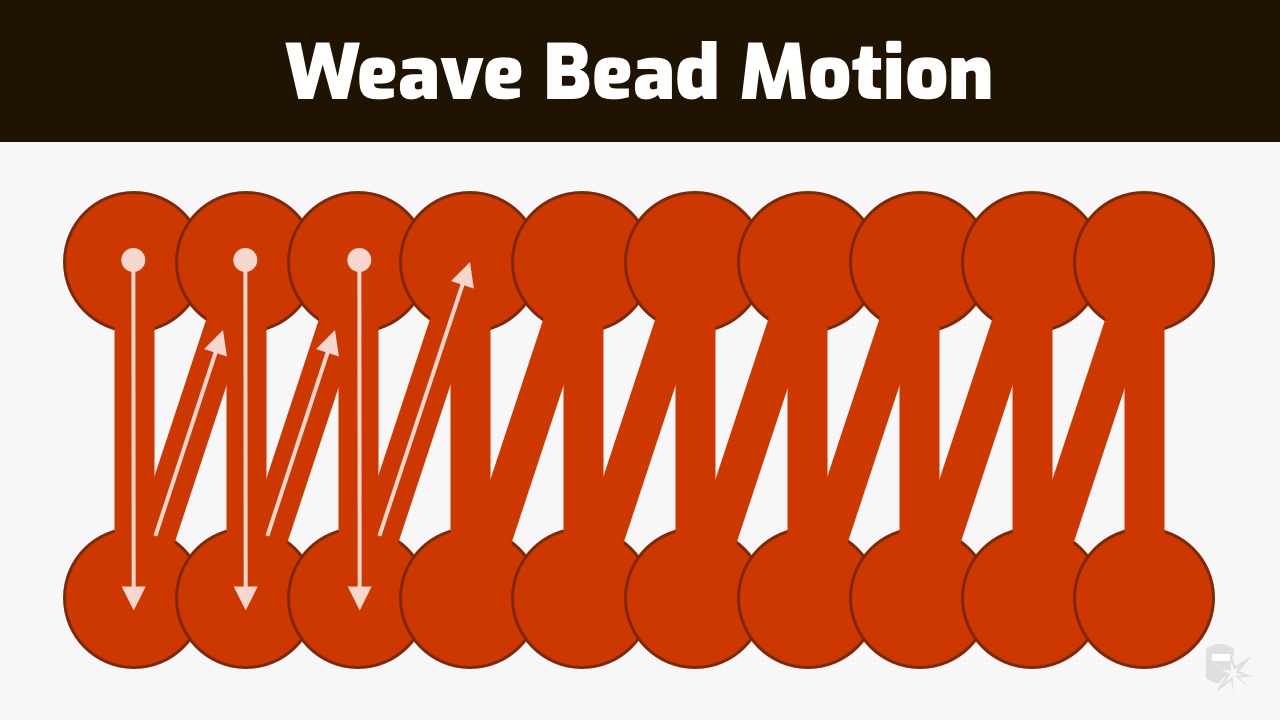
This often happens because the user quickly passes the electrode by the joint’s edges. This motion creates localized high travel speeds that allow premature cooling of the molten pool.
Therefore, always go quickly through the center and pause on the edges of a weave pass.
Related read: Best MIG Welding Patterns Master
Excessive Arc Length
Holding a long arc length creates undercutting issues.
This happens because a long arc doesn’t provide evenly distributed heat energy to the weld zone.
This means some areas receive more heat and melt properly, and other areas solidify early because of low heat.
This imbalance disturbs the weld pool dynamics and causes undercutting.
Lack of Edge Preparation
Dirt or grit on the welding surfaces tends to block heat transfer. This causes undercutting due to a lack of fusion between the base metal and filler.
If you don’t grind the surface to the proper shape before welding, its ridges and craters can also cause undercutting through bad heat penetration, bad liquid flow, and over/under-sizing.
10 Quick Tips to Prevent Undercut in Welding
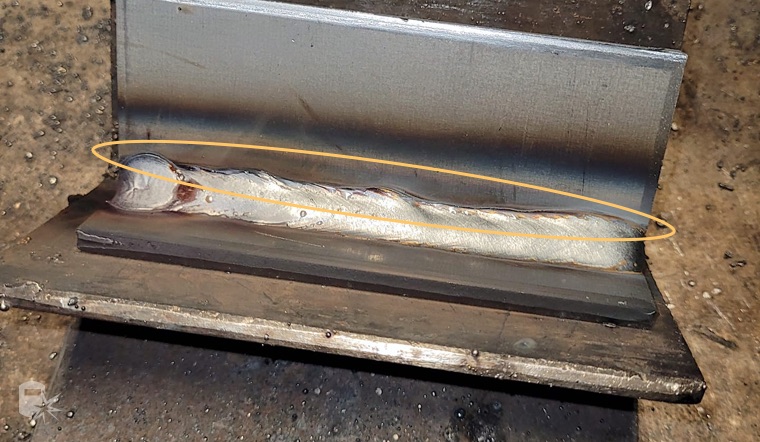
© weldguru.com – Image usage rights
Here are a few tips and tricks to prevent undercut when welding:
- Use the Right Current: Try lowering the current if you see long, consistent undercuts. Doing this reduces overheating to get proper fusion.
- Use the Correct Voltage: Find the voltage knob’s sweet spot that produces no undercuts, a smooth finish, and an even bead profile.
- Never Weld in a Hurry: Move the stick gradually to provide ample time for fusion and avoid early solidifying.
- Use Compatible Fillers: Consult a chart or an experienced welder before choosing which filler material to use.
- Keep a Good Work Angle: Maintain an angle that deposits filler evenly in the weld pool. You can judge this by observing each side of the bead and noticing differences.
- Choose the Correct Electrode Size: A reasonable electrode fills up your groove and delivers energy evenly.
- Use Case-Appropriate Shielding: Make an informed choice based on the intended weld and ensure the gas mix is appropriate for the job.
- Weave With a Steady Hand: When weaving, slightly delay your stay at the edges to ensure proper fusion at these high-risk points. Watch it dig, and then watch it fill.
- Maintain a Stable Arc: Your arc length is incorrect if there’s excessive spatter or resistance to your movement. Adjust it using these indicators and maintain it throughout the weld.
- Prepare the Edge Well: Maintain the desired fillet grooves, smoothen them, and clean them like a professional.
Bonus Tip – Point at it: Undercut is underfill, which is when you didn’t give your electrode enough time to fill once you melted the parent metal. Therefore, point at the undercut to properly fill it with your consumables.
Removing Undercuts for a Bad Weld
Once you determine that an undercut is unacceptable, there are a few ways to fit it. You can fill undercuts with new weld beads like other cavity-based defects, like porosity or surface craters.
Since undercuts are often narrow and long, stringing or weaving are popular methods to fill them up. The welder can decide between these methods by evaluating the width of the undercut; wider sections require weaving.
Another option is to grind the flaw off thoroughly with an angle grinder. This technique is only viable if the joint is thick enough to withstand the decrease in strength; normally, it’s not.
Professionals sometimes add a filler layer after grinding to restore the original thickness for thinner weldments.
Types of Undercut
An undercut is classified as either internal or external.
External Undercut
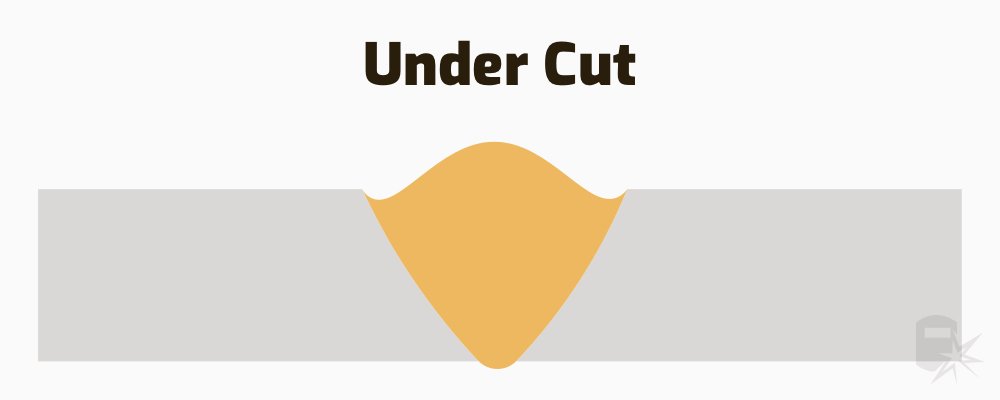
External undercut appears at the toe of the weld. In a fillet weld, it’s on the front of the joint, which is visible during welding.
External undercuts are more common since the front surface is closer to the weld gun.
Internal Undercut
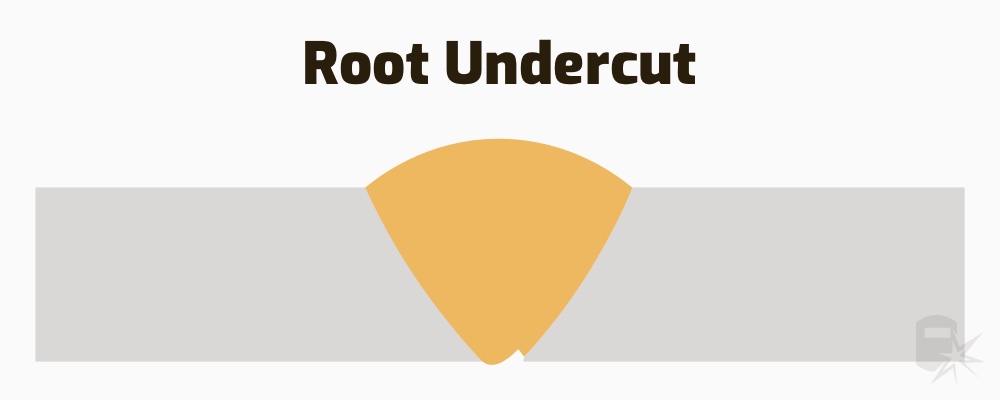
Internal undercut forms on the bottom side of a butt joint. Technically speaking, it’s at the root of the weldment. It’s also known as root undercut.
Quick Undercut FAQs
What is the main cause of undercut in welding?
Undercut can occur for several reasons, such as excessive heat from high current and voltage settings.
If the travel speed is too fast, the electrode moves away from the weld pool prematurely.
If you don’t prepare the edges properly, dirt or grit on the welding surfaces block proper fusion, which can cause undercutting.
Does undercut weaken a weld?
Undercut can weaken the joint’s structural integrity. In most cases, these low-thickness areas are the first to crack under loading.
Undercut can also decrease a joint’s strength by trapping water and dirt since captured water accelerates corrosion.
How do you correct undercut in welding?
Since undercuts are often narrow and long, stringer or weaving beads can fill them.
You can also grind the flaw off with an angle grinder. This technique only works if the joint is thick enough to withstand the decrease in strength, and it usually isn’t.
Conclusion
It has been a long read, but this topic is complex. Undercuts aren’t easy to avoid. Even with lots of time and practice, your experience doesn’t guarantee that you’ll never face this issue.
So, you must know how to deal with it like a professional. Plus, practice as much as possible to keep undercutting to a minimum.
We hope you find this article informative and learn something from it. Please don’t hesitate to leave a comment with any questions.
